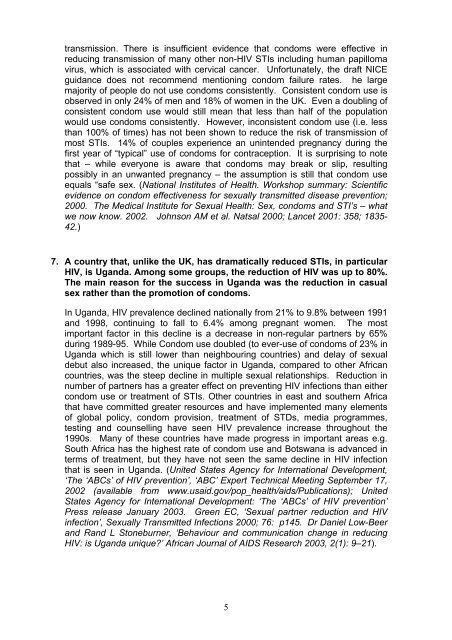STIs & Teenage pregnancy
STIs & Teenage pregnancy - The Maranatha Community
STIs & Teenage pregnancy - The Maranatha Community
You also want an ePaper? Increase the reach of your titles
YUMPU automatically turns print PDFs into web optimized ePapers that Google loves.
transmission. There is insufficient evidence that condoms were effective inreducing transmission of many other non-HIV <strong>STIs</strong> including human papillomavirus, which is associated with cervical cancer. Unfortunately, the draft NICEguidance does not recommend mentioning condom failure rates. he largemajority of people do not use condoms consistently. Consistent condom use isobserved in only 24% of men and 18% of women in the UK. Even a doubling ofconsistent condom use would still mean that less than half of the populationwould use condoms consistently. However, inconsistent condom use (i.e. lessthan 100% of times) has not been shown to reduce the risk of transmission ofmost <strong>STIs</strong>. 14% of couples experience an unintended <strong>pregnancy</strong> during thefirst year of “typical” use of condoms for contraception. It is surprising to notethat – while everyone is aware that condoms may break or slip, resultingpossibly in an unwanted <strong>pregnancy</strong> – the assumption is still that condom useequals “safe sex. (National Institutes of Health. Workshop summary: Scientificevidence on condom effectiveness for sexually transmitted disease prevention;2000. The Medical Institute for Sexual Health: Sex, condoms and STI’s – whatwe now know. 2002. Johnson AM et al. Natsal 2000; Lancet 2001: 358; 1835-42.)7. A country that, unlike the UK, has dramatically reduced <strong>STIs</strong>, in particularHIV, is Uganda. Among some groups, the reduction of HIV was up to 80%.The main reason for the success in Uganda was the reduction in casualsex rather than the promotion of condoms.In Uganda, HIV prevalence declined nationally from 21% to 9.8% between 1991and 1998, continuing to fall to 6.4% among pregnant women. The mostimportant factor in this decline is a decrease in non-regular partners by 65%during 1989-95. While Condom use doubled (to ever-use of condoms of 23% inUganda which is still lower than neighbouring countries) and delay of sexualdebut also increased, the unique factor in Uganda, compared to other Africancountries, was the steep decline in multiple sexual relationships. Reduction innumber of partners has a greater effect on preventing HIV infections than eithercondom use or treatment of <strong>STIs</strong>. Other countries in east and southern Africathat have committed greater resources and have implemented many elementsof global policy, condom provision, treatment of STDs, media programmes,testing and counselling have seen HIV prevalence increase throughout the1990s. Many of these countries have made progress in important areas e.g.South Africa has the highest rate of condom use and Botswana is advanced interms of treatment, but they have not seen the same decline in HIV infectionthat is seen in Uganda. (United States Agency for International Development,‘The ‘ABCs’ of HIV prevention’, ‘ABC’ Expert Technical Meeting September 17,2002 (available from www.usaid.gov/pop_health/aids/Publications); UnitedStates Agency for International Development: ‘The ‘ABCs’ of HIV prevention’Press release January 2003. Green EC, ‘Sexual partner reduction and HIVinfection’, Sexually Transmitted Infections 2000; 76: p145. Dr Daniel Low-Beerand Rand L Stoneburner, ‘Behaviour and communication change in reducingHIV: is Uganda unique?’ African Journal of AIDS Research 2003, 2(1): 9–21).5








